Residential Location and Travel in the Reykjavik Capital Region
Abstract
:1. Introduction
1.1. Background and Research Questions
- Which associations exist between residential built environment characteristics and travel for commuting, selected non-work purposes, and overall car-driving distance among respondents in the Reykjavik region?
- Through which causal mechanisms do residential built environment characteristics in the Reykjavik region influence travel distances and modes?
1.2. Theoretical Approach
1.3. Earlier Empirical Studies
2. Materials and Methods
2.1. The Reykjavik Region
2.2. Research Design and Data
- Built environment characteristics: distance from dwelling to the main city center, distance from dwelling to the Smáralind second-order center, distance from dwelling to the closest local center, and local-area population density;
- Demographic characteristics: gender, age, number of household members younger than 7 years, number of household members aged 7–17, and number of household members 18 years or older;
- Socioeconomic characteristics: education level, workforce participation, personal income level, driver’s license for a car;
- Residential preferences for the following characteristics of the dwelling: nice view from the dwelling, proximity to green areas, undisturbed location, low housing costs, proximity to relatives and friends, proximity to workplace, proximity to a grocery store, proximity to a bus stop, private garden, high architectural and esthetic quality, familiar neighborhood, good school/kindergarten in the neighborhood, no social problems in the neighborhood, favorable investment object, easy access to shopping mall, not close to a major road, good opportunities for physical exercise, and proximity to the city center.
3. Results
3.1. Quantitative Patterns
3.1.1. Cross-Sectional Associations
Geographical Differences in Travel Behavior
Multivariate Analyses
3.1.2. Changes after Moving
3.2. Qualitative Insight
3.2.1. Rationales for Activity Location
3.2.2. Rationales for Travel Mode Choice
4. Discussion
Author Contributions
Funding
Data Availability Statement
Acknowledgments
Conflicts of Interest
Appendix A
| Variables | Respondents of the Reykjavik Capital Region (in 2019, N = 1146) | Population of the Reykjavik Capital Region (in 2011) [92,93] |
|---|---|---|
| Average number of persons per household | 2.89 | 2.53 |
| Average number of children aged 0–6 years per household | 0.31 | 0.27 |
| Average number of children aged 7–17 years per household | 0.49 | 0.38 |
| Average age among residents above 18 years of age | 49.4 | 45.1 |
| Gender (proportion female) | 56.2% | 50.3% |
| Proportion of workforce participants among residents above 18 years of age | 69.6% | 75.0% |
| Proportion with education at master’s level or higher among residents above 18 years of age | 33.0% | 27.5% |
| Average number of cars per household | 1.54 | 1.60 |
| ID | Location Type | Age | Gender | Employment | Completed Education | Household Annual Income (mill. ISK) | Housing Type | Time of Living in Residence | Household Members |
|---|---|---|---|---|---|---|---|---|---|
| M63 | Central downtown | 63 | Male | Employed | Education as skilled worker or craftsman/-woman | 14–16.99 | Duplex house | 5–10 years | 2 adults |
| F36 | Inner suburb | 36 | Female | Student | University college education, bachelor or similar | Missing | Apartment building (student housing | 1–2 years | 1 adult, 2 children 3 and 7 years |
| F73 | Close to local center | 73 | Female | Retired | High school or professional secondary school | 5–7.99 | Duplex house | More than 10 years | 2 adults |
| F58 | Central downtown | 58 | Female | Employed | University education, master’s or higher | 14–16.99 | Apartment building | Less than 1 year | Single |
| F30 | Close to peripheral local center | 30 | Female | Employed | University education, master’s or higher | 8–10.99 | Detached single-family house | 1–2 years | 2 adults, 2 children: 2 and 5 years |
| F52 | Close to Smáralind | 52 | Female | Employed | High school or professional secondary school | 5–7.99 | Apartment building | 1–2 years | 2 adults |
| M54 | Inner suburb | 54 | Male | Employed | University education, master’s or higher | 14–16.99 | Detached single-family house | More than 10 years | 3 adults |
| F39 | Center | 39 | Female | Neither employed nor student | University education, master’s or higher | 27 or more | Detached single-family house | 1–2 years | 2 adults, 3 children: 2, 7 and 12 years |
| F43 | Suburban | 43 | Female | Employed | University college education, bachelor or similar | 8–10.99 | Row house | 1–2 years | 3 adults, child 11 years |
| F47 | Suburban | 47 | Female | Employed | University education, master’s or higher | 24–26.99 | Detached single-family house | more than 10 years | 3 adults, child 11 years |
| M60 | Suburban | 60 | Male | Employed | High school or professional secondary school | 27 or more | Apartment building | 1–2 years | 1 adult |
| M19 | Suburban | 19 | Male | Pupil | Elementary school | missing | Duplex house | Under 1 year | 3 adults |
| M44 | Central downtown | 44 | Male | Employed | University education, master’s or higher | 27 or more | Apartment building | 1–2 years | 4 adults in survey/2 adults in interview after divorce |
References
- European Commission. A European Strategy for Low-Emission Mobility. Available online: https://ec.europa.eu/clima/policies/transport_en (accessed on 14 May 2021).
- Alexander, D.E. Highways, environmental impact. In Environmental Geology. Encyclopedia of Earth Science; Springer: Dordrecht, The Netherlands, 1999. [Google Scholar] [CrossRef]
- Seiler, A. Effects of infrastructure on nature. In COST Action 341, Habitat Fragmentation Due to Transportation Infrastructure: The European Review; European Commission Directorate-General for Research: Luxembourg, 2003; pp. 31–50, 201–211. [Google Scholar]
- EU DG Environment. Soil Sealing; EU DG Environment: Brussels, Belgium, 2018; Available online: https://ec.europa.eu/environment/soil/sealing_guidelines.htm (accessed on 23 March 2021).
- Ivehammar, P. How to Deal with the Encroachment Costs in Road Investment CBA. Ph.D. Thesis, Linköping University, Linköping, Sweden, 2006. [Google Scholar]
- OECD. OECD Proceedings: Towards Sustainable Transportation. The Vancouver Conference; OECD: Paris, France, 1997; Available online: https://www.oecd.org/greengrowth/greening-transport/2396815.pdf (accessed on 14 May 2021).
- European Conference of Ministers of Transport. Assessment and Decision Making for Sustainable Transport; OECD Publications Service: Paris, France, 2004. [Google Scholar] [CrossRef]
- Commission of European Communities. Green Paper on the Impact of Transport on the Environment: A Community Strategy for Sustainable Mobility; Commission of European Communities: Brussels, Belgium, 1992; Available online: https://op.europa.eu/en/publication-detail/-/publication/98dc7e2c-6a66-483a-875e-87648c1d75c8/language-en (accessed on 14 May 2021).
- Holden, E. Achieving Sustainable Mobility: Everyday and Leisure-Time Travel in the EU; Routledge: London, UK, 2016. [Google Scholar]
- Banister, D. The sustainable mobility paradigm. Transp. Policy 2008, 15, 73–80. [Google Scholar] [CrossRef]
- Van Acker, V.; Van Wee, B.; Witlox, F. When Transport Geography Meets Social Psychology: Toward a Conceptual Model of Travel Behaviour. Transp. Rev. 2010, 30, 219–240. [Google Scholar] [CrossRef] [Green Version]
- Næss, P. Built environment, causality and travel. Transp. Rev. 2015, 35, 275–291. [Google Scholar] [CrossRef] [Green Version]
- Lewis-Beck, M. Applied Regression: An Introduction; Sage Publication: Newbury Park, CA, USA, 1980. [Google Scholar]
- Næss, P.; Peters, S.; Stefansdottir, H.; Strand, A. Causality, not just correlation: Residential location, transport rationales and travel behavior across metropolitan contexts. J. Transp. Geogr. 2018, 69, 181–195. [Google Scholar] [CrossRef]
- Plano-Clark, V.; Anderson, N.; Wertz, J.; Zhou, Y.; Schumacher, K.; Miaskowski, C. Conceptualizing longitudinal mixed methods designs: A methodological review of health sciences research. J. Mix. Method Res. 2015, 9, 297–319. [Google Scholar] [CrossRef]
- Ewing, R.; Cervero, R. Travel and the built environment. J. Am. Plan. Assoc. 2010, 76, 1–30. [Google Scholar] [CrossRef]
- Stevens, M.R. Does compact development make people drive less? J. Am. Plan. Assoc. 2017, 83, 7–18. [Google Scholar] [CrossRef]
- Handy, S.L.; Boarnet, M.G.; Ewing, R.; Killingsworth, R.E. How the built environment affects physical activity: Views from urban planning. Am. J. Prev. Med. 2002, 23, 64–73. [Google Scholar] [CrossRef]
- Cao, X.; Mokhtarian, P.L.; Handy, S. Examining the impacts of residential self-selection on travel behavior: A focus on empirical findings. Transp. Rev. 2009, 29, 359–395. [Google Scholar] [CrossRef]
- Saelens, B.E.; Handy, S. Built environment correlates of walking: A review. Med. Sci. Sport Exer. 2008, 40, S550–S566. [Google Scholar] [CrossRef] [PubMed] [Green Version]
- Næss, P. Urban form and travel behavior: Experience from a Nordic context. J. Transp. Land Use 2012, 5, 21–45. [Google Scholar] [CrossRef]
- Næss, P. ‘New urbanism’ or metropolitan-level centralization? A comparison of the influences of metropolitan-level and neighborhood-level urban form characteristics on travel behavior. J. Transp. Land Use 2011, 4, 25–44. [Google Scholar]
- Næss, P.; Strand, A.; Wolday, F.; Stefansdottir, H. Residential location, commuting and non-work travel in two urban areas of different size and with different center structures. Prog. Plan. 2019, 128, 1–36. [Google Scholar] [CrossRef] [Green Version]
- Van Acker, V.; Witlox, F. Commuting trips within tours: How is commuting related to land use? Transportation 2011, 38, 465–486. [Google Scholar] [CrossRef]
- Scheiner, J.; Holz-Rau, C. Travel mode choice: Affected by objective or subjective determinants? Transportation 2007, 34, 487–511. [Google Scholar] [CrossRef]
- Moreno, C.; Transcript of “La ville d’un quart d’heure”. TED Talks. 2020. Available online: https://www.ted.com/talks/carlos_moreno_the_15_minute_city/transcript?language=fr (accessed on 14 May 2021).
- Weng, M.; Ding, N.; Li, J.; Jin, X.; Xiao, H.; He, Z.; Su, S. The 15-minute walkable neighborhoods: Measurement, social inequalities and implications for building healthy communities in urban China. J. Transp. Health 2019, 13, 259–273. [Google Scholar] [CrossRef]
- Da Silva, D.C.; King, D.A.; Lemar, S. Accessibility in practice: 20-minute city as a sustainability planning goal. Sustainability 2019, 12, 129. [Google Scholar] [CrossRef] [Green Version]
- CNU. Canons of Sustainable Architecture and Urbanism: A Companion to the Charter of New Urbanism. Available online: http://www.cnu.org/sites/files/Canons.pdf (accessed on 25 March 2013).
- Alonso, W. Location and Land Use; Harvard University Press: Cambridge, MA, USA, 1964. [Google Scholar]
- Fishman, R. Bourgeois utopias: Visions of suburbia. In Readings in Urban Theory; Fainstein, S., Campbell, S., Eds.; Blackwell: Malden, MA, USA, 1996; pp. 23–71. [Google Scholar]
- Næss, P. Residential location affects travel behavior—But how and why? The case of Copenhagen Metropolitan Area. Prog. Plan. 2005, 63, 167–257. [Google Scholar] [CrossRef]
- Gibson, J. The theory of affordances. In Perceiving, Acting, and Knowing: Toward an Ecological Psychology; Shaw, R., Bransford, J., Eds.; Lawrence Erlbaum Associates: Hillsdale, NJ, USA, 1977; pp. 67–82. [Google Scholar]
- Østerberg, D. Arkitektur og Sosiologi i Oslo: En Sosiomateriell Fortolkning; Pax: Oslo, Norway, 1998. [Google Scholar]
- Bhaskar, R. Enlightened Common Sense. The Philosophy of Critical Realism; Routledge: London, UK, 2016. [Google Scholar]
- Danermark, B.; Ekström, M.; Karlsson, J.C. Explaining Society. Critical Realism in the Social Sciences, 2nd ed.; Routledge: London, UK, 2019. [Google Scholar]
- Berry, B.J.; Garrison, W.L. Recent developments of central place theory. Pap. Reg. Sci. 1958, 4, 107–120. [Google Scholar] [CrossRef]
- Milakis, D.; Cervero, R.; van Wee, B. Stay local or go regional? Urban form effects on vehicle use at different spatial scales: A theoretical concept and its application to the San Francisco Bay Area. J. Transp. Land Use 2015, 8, 59–86. [Google Scholar] [CrossRef] [Green Version]
- Heinonen, J.; Czepkiewicz, M.; Ottelin, J. Drivers of car ownership in a car-oriented city: A mixed-method study. Sustainability 2021, 13, 619. [Google Scholar] [CrossRef]
- Stefánsdóttir, H. Pleasurable Cycling to Work. Urban Spaces and Aesthetic Experiences of Commuting Cyclists. Ph.D. Thesis, Norwegian University of Life Sciences, Ås, Norway, 2014. [Google Scholar]
- Næss, P.; Jensen, O.B. Bilringene og Cykelnavet. Boliglokalisering, Bilafhængighed og Transportadfærd i Hovedstadsområdet; Aalborg University Press: Aalborg, Denmark, 2005. [Google Scholar]
- Hägerstrand, T. What about people in regional science? Pap. Reg. Sci. Assoc. 1970, 24, 7–21. [Google Scholar] [CrossRef]
- Schwanen, T. Struggling with time: Investigating coupling constraints. Transp. Rev. 2008, 28, 337–356. [Google Scholar] [CrossRef] [Green Version]
- Ellegård, K.; Svedin, U. Torsten Hägerstrand’s time-geography as the cradle of the activity approach in transport geography. J. Transp. Geogr. 2012, 23, 17–25. [Google Scholar] [CrossRef] [Green Version]
- Ellegård, K. Thinking Time Geography; Routledge: London, UK, 2019. [Google Scholar]
- Ma, L.; Cao, J. How perceptions mediate the effects of the built environment on travel behavior? Transportation 2019, 46, 175–197. [Google Scholar] [CrossRef]
- Mogridge, M.H.J. Transport, land use and energy interaction. Urban Stud. 1985, 22, 481–492. [Google Scholar] [CrossRef]
- Newman, P.W.G.; Kenworthy, J.R. Cities and Automobile Dependence; Gower Publications: Aldershot, UK, 1989. [Google Scholar]
- Zhou, B.; Kockelman, K. Self-selection in home choice: Use of treatment effects in evaluating the relationship between the built environment and travel behavior. Transp. Res. Rec. 2008, 2077, 54–61. [Google Scholar] [CrossRef] [Green Version]
- Milakis, D.; Vlastos, T.; Barbopoplos, N. Relationships between urban form and travel behaviour in Athens, Greece. A comparison with western European and North American results. Eur. J. Transp. Infrast. 2008, 8, 201–215. [Google Scholar]
- Næss, P. Residential location, travel and energy use: The case of Hangzhou Metropolitan Area. J. Transp. Land Use 2010, 3, 27–59. [Google Scholar] [CrossRef]
- Zegras, C. The built environment and motor vehicle ownership and use: Evidence from Santiago de Chile. Urban Stud. 2010, 47, 1793. [Google Scholar] [CrossRef]
- Wang, X.; Shao, C.; Yin, C.; Zhuge, C. Exploring the influence of built environment on car ownership and use with a spatial multilevel model: A case study of Changchun, China. Int. J. Environ. Res. Public Health 2018, 15, 1868. [Google Scholar] [CrossRef] [PubMed] [Green Version]
- Engebretsen, Ø.; Næss, P.; Strand, A. Residential location, workplace location and car driving in four Norwegian cities. Eur. Plan. Stud. 2018, 26, 2036–2057. [Google Scholar] [CrossRef] [Green Version]
- Næss, P.; Røe, P.G.; Larsen, S.L. Travelling distances, modal split and transportation energy in thirty residential areas in Oslo. J. Environ. Plan. Manag. 1995, 38, 349–370. [Google Scholar] [CrossRef]
- Røe, P.G. Storbymenneskets Hverdagsreiser. Sammenhenger Mellom Bosted, Livsstil og Hverdagsreisepraksis i et Senmoderne Perspektiv. Ph.D. Thesis, Norwegian University of Technology and Science, Trondheim, Norway, 2001. [Google Scholar]
- Næss, P.; Cao, X.; Strand, A. Which D’s are the important ones? The effects of built environment characteristics on driving distance in Oslo and Stavanger. J. Transp. Land Use 2017, 10, 945–964. [Google Scholar] [CrossRef] [Green Version]
- Næss, P.; Jensen, O.B. Urban structure matters, even in a small town. J. Environ. Plan. Manag. 2004, 47, 35–56. [Google Scholar] [CrossRef]
- Nielsen, T.A.S. Boliglokalisering og Transport i Aalborg. Ph.D. Thesis, Aalborg University, Aalborg, Denmark, 2002. [Google Scholar]
- Hartoft-Nielsen, P. Boliglokalisering og Transportadfærd; Danish Forest and Landscape Research Institute: Hørsholm, Denmark, 2001. [Google Scholar]
- Elldér, E. Residential location and daily travel distances: The influence of trip purpose. J. Transp. Geogr. 2014, 34, 121–130. [Google Scholar] [CrossRef]
- Elldér, E. Does telework weaken urban structure–travel relationships? J. Transp. Land Use 2017, 10, 187–210. [Google Scholar] [CrossRef]
- Czepkiewicz, M.; Ottelin, J.; Ala-Mantila, S.; Heinonen, J.; Hasanzadeh, K.; Kyttä, M. Urban structural and socioeconomic effects on local, national and international travel patterns and greenhouse gas emissions of young adults. J. Transp. Geogr. 2018, 68, 130–141. [Google Scholar] [CrossRef]
- Handy, S.L. Regional versus local accessibility: Implication for non-work travel. Transp. Res. Rec. 1993, 1400, 58–66. [Google Scholar]
- Handy, S.L.; Clifton, K.L. Local shopping as a strategy for reducing automobile travel. Transportation 2001, 28, 317–346. [Google Scholar] [CrossRef]
- Nielsen, T.A.S. The role of subcentres for commuting and non-work travel distances and modes in the Copenhagen metropolitan region. Built Environ. 2019, 45, 462–475. [Google Scholar] [CrossRef]
- Næss, P. Residential location and travel behavior. In Mobility Patterns and Urban Structure; Pinho, P., Silva, C., Eds.; Ashgate: Farnham, UK, 2015; pp. 151–186. [Google Scholar]
- Lee, B.; Gordon, P.; Moore II, J.E.; Richardson, H. The attributes of residence/workplace areas and transit commuting. J. Transp. Land Use 2011, 4, 43–63. [Google Scholar] [CrossRef]
- Holden, E.; Norland, I.T. En Undersøkelse av Husholdningers Forbruk av Energi Til Bolig og Transport i Stor-Oslo; University of Oslo: Oslo, Norway, 2004. [Google Scholar]
- City Population, Iceland, Major Localities, Reykjavik. Available online: https://www.citypopulation.de/en/iceland/ (accessed on 23 April 2021).
- Sieverts, T. Zwischenstadt: Zwischen Ort und Welt, Raum und Zeit, Stadt und Land; Birkhäuser: Basel, Switzerland, 1999. [Google Scholar]
- Meijers, E.; Hoogerbrugge, M.; Cardoso, C. Beyond polycentricity: Does stronger integration between cities in polycentric urban regions improve performance? Tijdschr. Econ. Soc. Geogr. 2017, 109, 1–21. [Google Scholar] [CrossRef] [Green Version]
- Association of Municipalities in the Reykjavik Capital Region. Available online: https://geo.alta.is/ssh/ (accessed on 28 April 2021).
- Statistics Iceland, Registered Motor Vehicles. Passenger Cars, 1–8 Passengers. Available online: https://www.statice.is/statistics/business-sectors/transport/vehicles/ (accessed on 20 January 2020).
- Reykjavík City, Reykjavík í Tölum. Available online: http://tolur.reykjavik.is/ (accessed on 14 May 2020).
- Gallup Iceland, Samgöngu-og Sveitarstjórnarráðuneytið, Samtök sveitarfélaga á höfuðborgarsvæðinu, Vegagerðin, Samgöngustofa og Isavia—Ferðir íbúa Höfuðborgarsvæðisins, Október-Nóvember. 2019. Available online: https://www.stjornarradid.is/library/01--Frettatengt---myndir-og-skrar/SAM/02_H%c3%b6fu%c3%b0borgarsv%c3%a6%c3%b0i%c3%b0.pdf (accessed on 30 October 2020).
- Valsson, T. Planning in Iceland: From Settlement to Present Times; University of Iceland Press: Reykjavík, Iceland, 2003. [Google Scholar]
- Reykjavík City, Reykjavík Municipal Plan 2010–2030. Available online: http://adalskipulag.is (accessed on 20 January 2020).
- Næss, P. Residential location, transport rationales and daily-life travel behavior: The case of Hangzhou Metropolitan Area, China. Prog. Plan. 2013, 79, 1–50. [Google Scholar] [CrossRef]
- Næss, P.; Tønnesen, A.; Wolday, F. How and why does intra-metropolitan workplace location affect car commuting? Sustainability 2019, 11, 1196. [Google Scholar] [CrossRef] [Green Version]
- Næss, P. Residential self-selection and appropriate control variables in land use–travel studies. Transp. Rev. 2009, 29, 293–324. [Google Scholar] [CrossRef]
- Næss, P. Tempest in a teapot: The exaggerated problem of transport-related residential self-selection as a source of error in empirical studies. J. Transp. Land Use 2014, 7, 57–77. [Google Scholar] [CrossRef]
- Wolday, F.; Cao, X.; Næss, P. Examining factors that keep residents with high transit preference away from transit-rich zones and associated behavior outcomes. J. Transp. Geogr. 2018, 66, 224–234. [Google Scholar] [CrossRef]
- Wolday, F.; Næss, P.; Cao, J. Travel-based residential self-selection: A qualitatively improved understanding from Norway. Cities 2019, 87, 87–102. [Google Scholar] [CrossRef]
- Crano, W.D.; Brewer, M.B.; Lac, A. Principles and Methods of Social Research, 3rd ed.; Routledge: New York, NY, USA, 2015. [Google Scholar]
- Giuliano, G.; Narayan, D. Another look at travel patterns and urban form: The US and Great Britain. Urban Stud. 2003, 40, 2295–2312. [Google Scholar] [CrossRef] [Green Version]
- Cao, J.; Næss, P.; Wolday, F. Examining the effects of the built environment on auto ownership in two Norwegian urban regions. Transp. Res. 2019, 67, 464–474. [Google Scholar]
- Næss, P. Validating explanatory qualitative research: Enhancing the interpretation of interviews in urban planning and transportation research. Appl. Mobilities 2020, 5, 186–205. [Google Scholar] [CrossRef]
- Norusis, M.J. SPSS Base System User’s Guide; SPSS Inc.: Chicago, IL, USA, 1990. [Google Scholar]
- Lloyd, P.E.; Dicken, P. Location in Space—A Theoretical Approach to Economic Geography; Harper and Row: London, UK, 1977. [Google Scholar]
- Headicar, P. The exploding city region: Should it, can it, be reversed? In Achieving Sustainable Urban Form; Williams, K., Burton, E., Jenks, M., Eds.; Spon: London, UK, 2000; pp. 160–173. [Google Scholar]
- Statistics Iceland Online Database. Available online: https://px.hagstofa.is/pxen/pxweb/en/?rxid=44a7b72d-c137-4b86-8150-3c4a6a758600 (accessed on 20 February 2021).
- Reykjavikurborg Online Database. Available online: https://tolur.reykjavik.is/PxWeb/pxweb/en/05%20Transport/05%20Transport__01.%20Car%20ownership%20and%20traffic/SAM01001.px/?rxid=0895a024-ab8a-4a03-b122-540838af0989 (accessed on 20 February 2021).
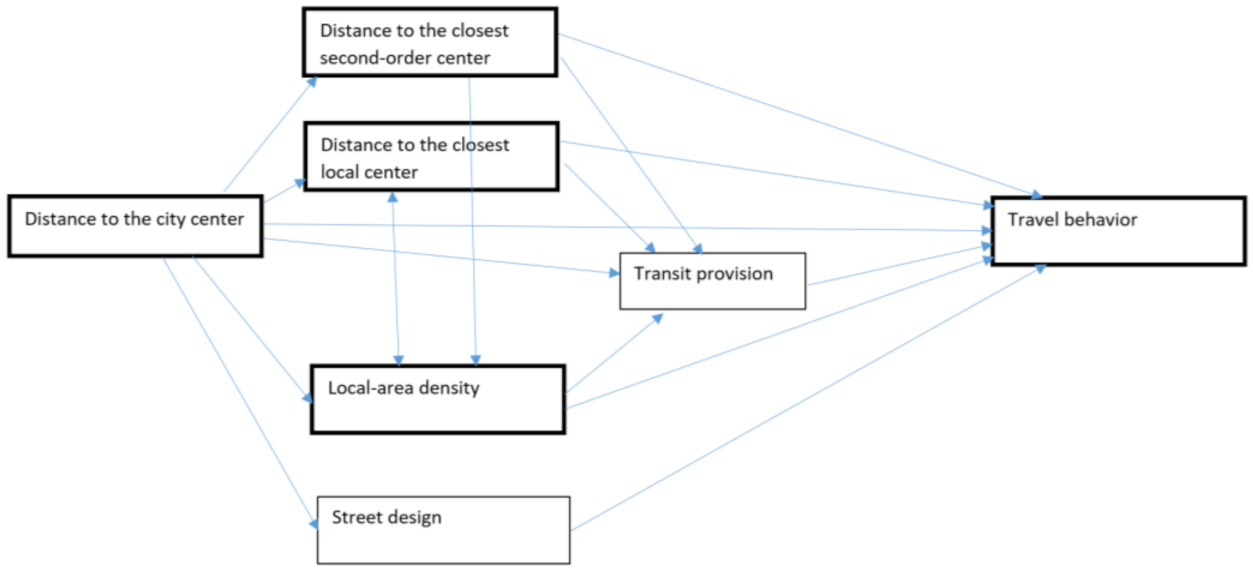
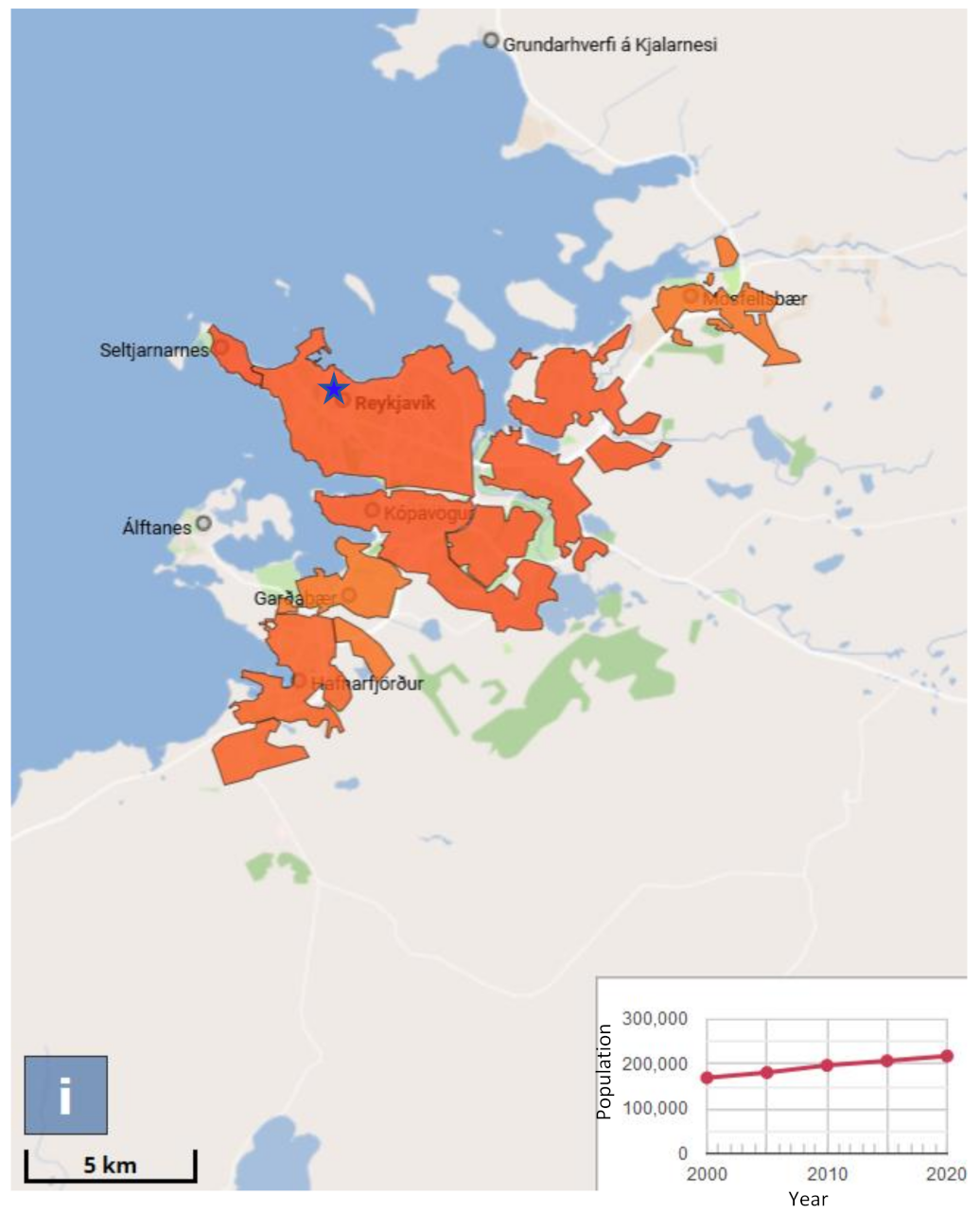

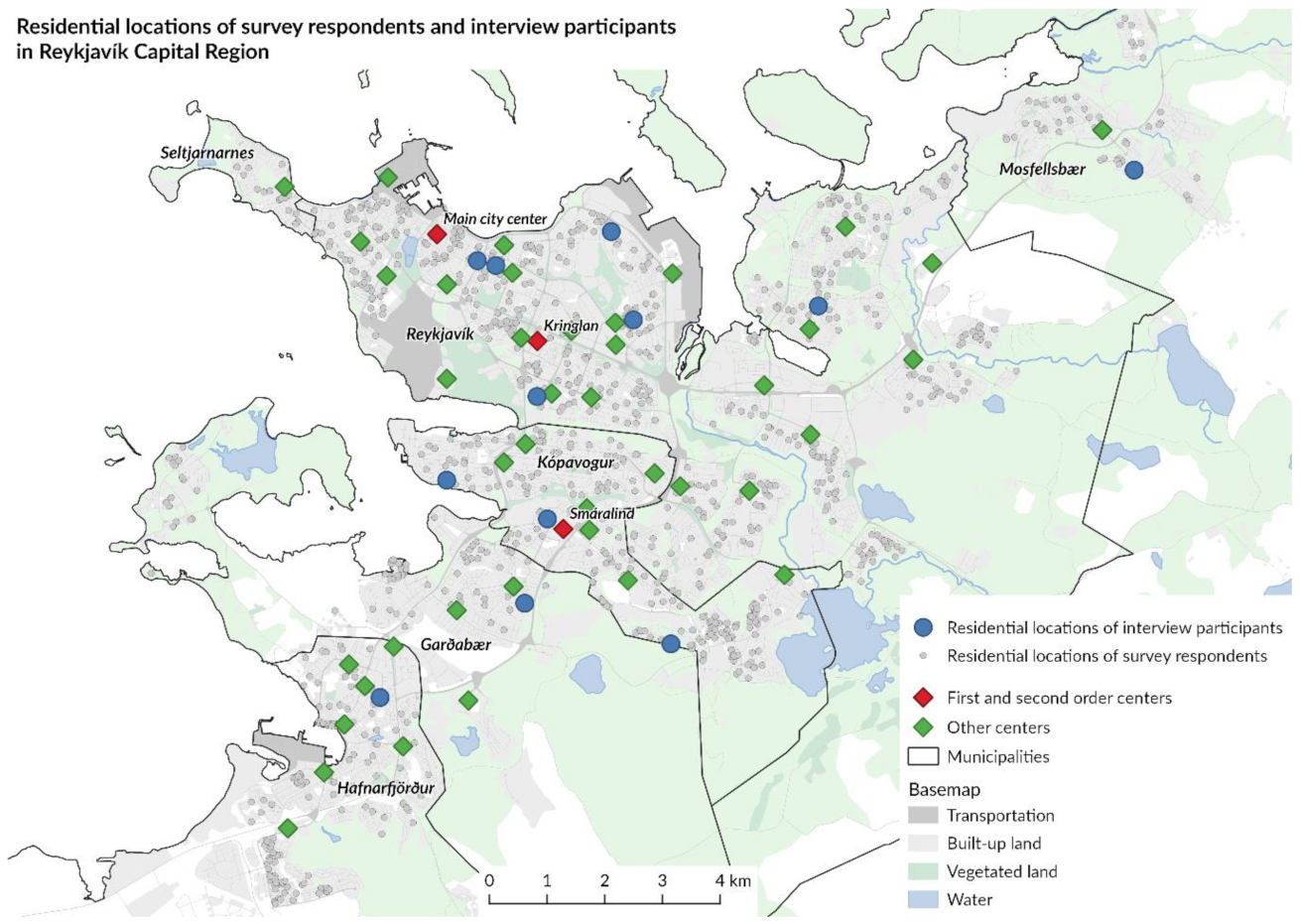
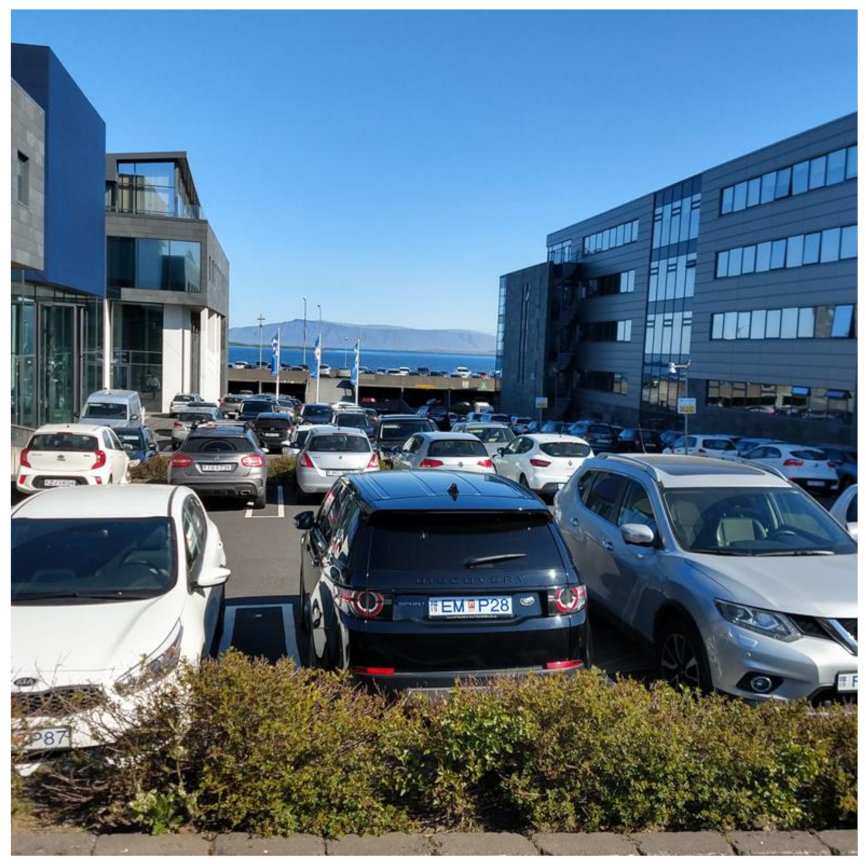
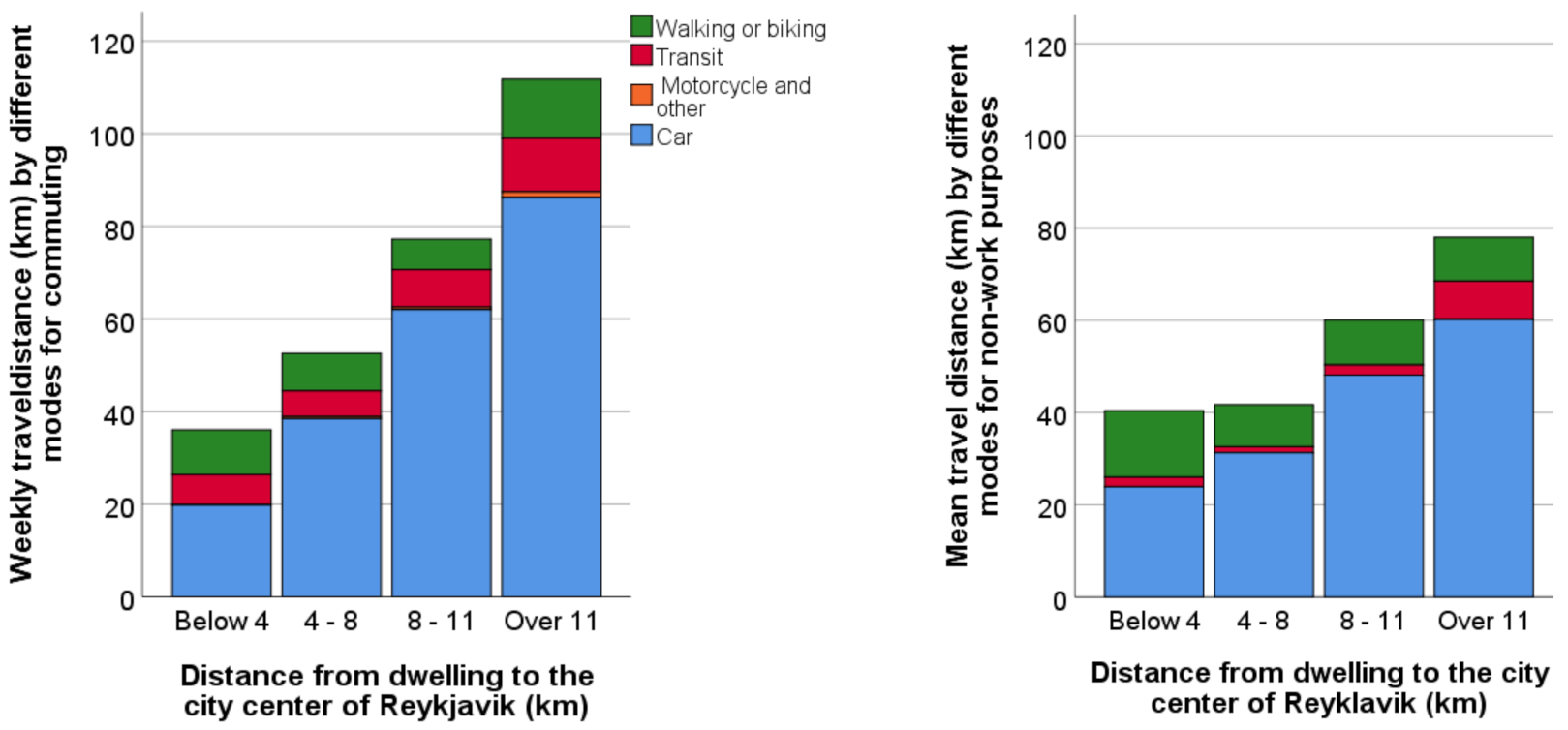

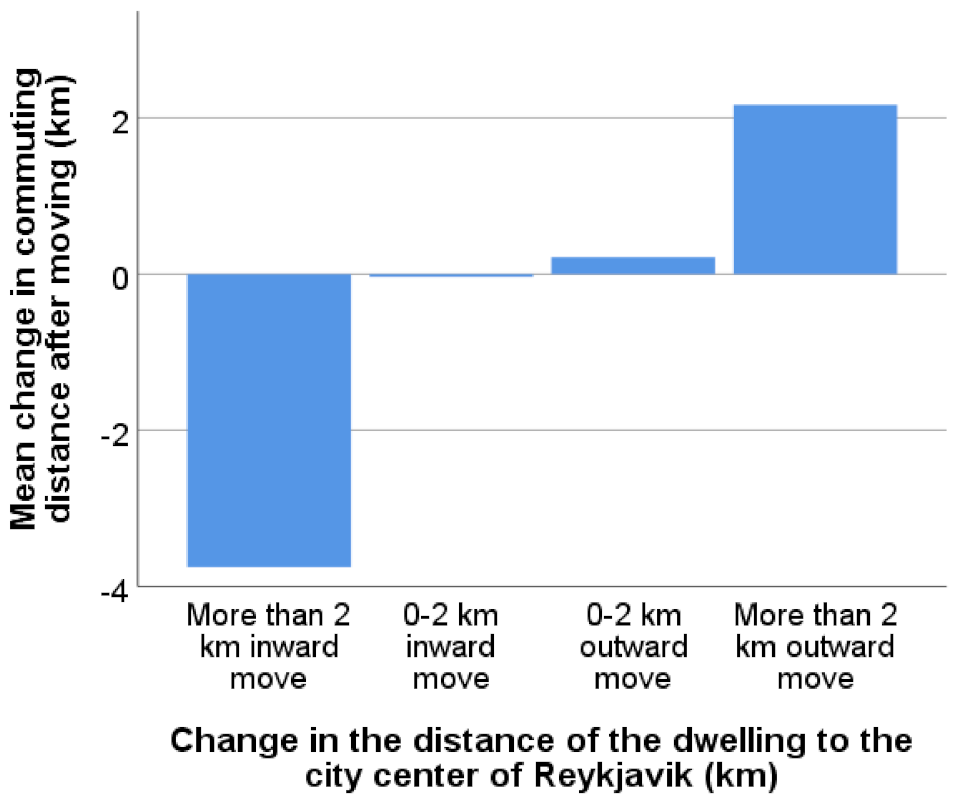
| Estimate | Robust Standard Error | 95% CI | p-Value | |
|---|---|---|---|---|
| Built environment characteristics | ||||
| Distance from residence to the city center of Reykjavik (km) | 0.491 | 0.046 | (0.401–0.582) | 0.000 |
| Distance from residence to the Smáralind second-order center (km) | 0.067 | 0.052 | (−0.034–0.168) | 0.192 |
| Distance from residence to the closest local center (km) | 0.148 | 0.271 | (−0.382–0.679) | 0.583 |
| Inhabitants per hectare within the 1 km2 circle around the dwelling | −0.0026 | 0.0115 | (−0.025–0.020) | 0.824 |
| Demographic and socioeconomic characteristics | ||||
| Driver’s license for a car | 1.160 | 0.524 | (2.188–4.894) | 0.027 |
| Personal income level | 0.088 | 0.042 | (0.006–0.171) | 0.036 |
| Number of household members below 7 years of age | 0.452 | 0.238 | (−0.015–0.919) | 0.058 |
| Residential preferences | ||||
| Preference for proximity to workplace | −1.341 | 0.157 | (−1.649–−1.034) | 0.000 |
| Preference for proximity to a grocery store | 0.529 | 0.175 | (0.186–0.871) | 0.003 |
| Preference for good opportunities for physical exercise | 0.304 | 0.155 | (0.000–0.608) | 0.050 |
| Preference for proximity to green areas | −0.288 | 0.158 | (−0.598–0.022) | 0.068 |
| Constant | −0.898 | 1.499 | (−3.835–2.040) | 0.549 |
| Estimate | Robust Standard Error | 95% CI | p-Value | |
|---|---|---|---|---|
| Built environment characteristics | ||||
| Distance from residence to the city center of Reykjavik (km) | 0.157 | 0.038 | (0.083–0.232) | 0.000 |
| Distance from residence to the closest local center (km) | −0.158 | 0.181 | (−0.512–0.196) | 0.383 |
| Inhabitants per hectare within the 1 km2 circle around the dwelling | 0.002 | 0.009 | (−0.016–0.020) | 0.825 |
| Distance from residence to the Smáralind second-order center (km) | 0.005 | 0.394 | (−0.072–0.082) | 0.897 |
| Demographic and socioeconomic characteristics | ||||
| Driver’s license for a car | 2.632 | 0.790 | (1.083–4.181) | 0.001 |
| Female | 0.536 | 0.213 | (0.118–0.953) | 0.012 |
| Residential preferences | ||||
| Preference for proximity to a bus stop | −0.652 | 0.112 | (−0.871–−0.434) | 0.000 |
| Preference for proximity to workplace | −0.333 | 0.121 | (−0.871–−0.434) | 0.006 |
| Preference for easy access to shopping mall | 0.354 | 0.138 | (−0.084–−0.624) | 0.010 |
| Preference for undisturbed location | 0.338 | 0.140 | (0.064–0.611) | 0.015 |
| Preference for good opportunities for physical exercise | −0.273 | 0.119 | (−0.507–−0.039) | 0.022 |
| Preference for low housing costs | −0.196 | 0.098 | (−0.389–−0.004) | 0.046 |
| Preference for private garden | 0.169 | 0.095 | (−0.018–0.356) | 0.076 |
| Constant | 4.61 | 1.31 | (2.03–7.19) | 0.000 |
| Estimate | Robust Standard Error | 95% CI | p-Value | |
|---|---|---|---|---|
| Built environment characteristics | ||||
| Logarithm of distance from residence to the city center of Reykjavik (km) | 0.064 | 0.016 | (0.031–0.096) | 0.000 |
| Logarithm of distance from residence to the closest local center (km) | 0.049 | 0.017 | (0.017–0.082) | 0.003 |
| Inhabitants per hectare within the 1 km2 circle around the dwelling | −0.0017 | 0.0009 | (−0.0033–0.0000) | 0.052 |
| Logarithm of distance from residence to the Smáralind second-order center (km) | 0.000 | 0.017 | (−0.034–0.034) | 0.990 |
| Demographic and socioeconomic characteristics | ||||
| Driver’s license for a car | 0.277 | 0.061 | (0.158–0.397) | 0.000 |
| Workforce participation (yes = 1, no = 0) | 0.057 | 0.024 | (0.009–0.104) | 0.019 |
| Personal income level | 0.006 | 0.003 | (0.000–0.012) | 0.070 |
| Residential preferences | ||||
| Preference for proximity to a bus stop | −0.057 | 0.009 | (−0.074–−0.039) | 0.000 |
| Preference for easy access to shopping mall | 0.040 | 0.012 | (0.016–0.064) | 0.001 |
| Preference for undisturbed location | 0.044 | 0.014 | (0.018–0.071) | 0.001 |
| Preference for proximity to a grocery store | −0.035 | 0.014 | (−0.062–−0.008) | 0.011 |
| Preference for location not close to major road | −0.019 | 0.010 | (−0.039–0.001) | 0.059 |
| Constant | 0.330 | 0.107 | (0.121–0.539) | 0.002 |
| Estimate | Robust Standard Error | 95% CI | p-Value | |
|---|---|---|---|---|
| Built environment characteristics | ||||
| Distance from residence to the city center of Reykjavik (km) | 0.787 | 0.182 | (0.430–1.145) | 0.000 |
| Distance from residence to the closest local center (km) | 1.430 | 0.459 | (0.530–2.331) | 0.002 |
| Distance from residence to the Smáralind second-order center (km) | −0.140 | 0.204 | (−0.541–0.260) | 0.492 |
| Inhabitants per hectare within the 1 km2 circle around the dwelling | −0.032 | 0.049 | (−0.128–0.065) | 0.520 |
| Demographic and socioeconomic characteristics | ||||
| Female | −7.243 | 1.107 | (−9.412–−5.074) | 0.000 |
| Driver’s license for a car | 9.038 | 2.827 | (3.499–14.58) | 0.001 |
| Age | 0.075 | 0.045 | (−0.013–0.162) | 0.094 |
| Residential preferences | ||||
| Preference for proximity to a bus stop | −1.793 | 0.516 | (−2.805–−0.781) | 0.001 |
| Preference for neighborhood without social problems | −1.597 | 0.613 | (−2.797–−0.396) | 0.009 |
| Preference for a familiar neighborhood | 1.253 | 0.548 | (0.178–2.327) | 0.022 |
| Constant | 7.23 | 6.49 | (−5.48–19.95) | 0.265 |
| Estimate | Robust Standard Error | 95% CI | p-Value | |
|---|---|---|---|---|
| Built environment characteristics | ||||
| Change in distance from residence to the city center of Reykjavik (km) | 0.341 | 0.075 | (0.194–0.488) | 0.000 |
| Change in distance from residence to the Smáralind second-order center (km) | 0.242 | 0.070 | (0.116–0.389) | 0.000 |
| Change in distance from residence to the closest local center (km) | −0.224 | 0.204 | (−0.624–0.175) | 0.271 |
| Change in inhabitants per hectare within the 1 km2 circle around the dwelling | −0.0022 | 0.0056 | (−0.013–0.009) | 0.691 |
| Demographic and socioeconomic characteristics | ||||
| Number of household members aged 7–17 | 0.467 | 0.230 | (0.015–0.919) | 0.043 |
| Residential preferences | ||||
| Preference for proximity to workplace | −0.412 | 0.180 | (−0.765–−0.059) | 0.022 |
| Preference for proximity to a grocery store | 0.397 | 0.209 | (−0.029–0.823) | 0.068 |
| Preference for neighborhood without social problems | −0.287 | 0.159 | (−0.598–0.024) | 0.071 |
| Constant |
| Trip Purpose | Increase in Total Amount of Travel (N = 340) | Increase in Travel by Car (N = 336) | Increase in Travel by Transit (N = 332) | Increase in Travel by Non-Motorized Modes (N = 336) | ||||
|---|---|---|---|---|---|---|---|---|
| Estimate and Robust Std. Error | p-Value | Estimate and Robust Std. Error | p-Value | Estimate and Robust Std. Error | p-Value | Estimate and Robust Std. Error | p-Value | |
| Increase in the distance (in km) to the main city center | 0.167 (0.049) | 0.001 | 0.176 (0.046) | 0.000 | 0.099(0.050) | 0.049 | −0.117 (0.045) | 0.009 |
| Increase in the distance (in km) to the Smáralind second-order center | 0.163 (0.052) | 0.002 | 0.165 (0.064) | 0.002 | 0.035 (0.056) | 0.535 | 0.057 (0.049) | 0.241 |
| Increase in the distance (in km) to the closest local center | 0.210 (0.151) | 0.166 | 0.260 (0.157) | 0.098 | −0.023 (0.217) | 0.916 | −0.009 (0.151) | 0.950 |
| Increase in inhabitants per hectare within the 1 km2 circle around the dwelling | 0.000 (0.0043) | 0.953 | −0.0006 (0.0043) | 0.881 | −0.000 (0.0061) | 0.975 | −0.0047 (0.0044) | 0.280 |
| Rationales for Location of Activities | Encourages Trip Distances among Inner-City Residents to Become | Encourages Trip Distances among Residents Living Close to Suburban Centers to Become | Encourages Trip Distances among Residents Living at Non-Central Locations to Become |
|---|---|---|---|
| Main rationales, applying to commuting as well as non-work trips: | |||
| Choosing the “best facility” | |||
| Generally | Shorter | Somewhat longer | Considerably longer |
| Workplace/place of education | Considerably shorter | Longer | Considerably longer |
| Non-work facilities | Shorter | Somewhat shorter | Longer |
| Minimizing the friction of distance | |||
| Generally | Shorter | Shorter | Longer |
| Accessibility by car | Longer | Somewhat shorter | Somewhat longer |
| Accessibility by non-motorized modes | Considerably shorter | Shorter | Longer |
| Less important rationales, applying mainly to non-wok trips: | |||
| Social contacts | Shorter | Somewhat shorter | Longer |
| Variety-seeking | Somewhat shorter | Slightly shorter | Somewhat longer |
| Place attachment | Ambiguous effect | Ambiguous effect | Ambiguous effect |
| Urban atmosphere | Somewhat shorter | Somewhat longer | Longer |
| Rationales for Travel Mode Choice | Travel Modes Encouraged for Inner-City Residents | Travel Modes Encouraged for Residents Living Close to Suburban Centers | Travel Modes Encouraged for Residents Living at Non-Central Locations |
|---|---|---|---|
| Main rationales | |||
| Time-saving | Non-motorized (local trips) and car (longer trips) | Car | Car |
| Convenience and comfort | Non-motorized (local trips) and car (longer trips) | Car | Car |
| Physical exercise | More non-motorized trips | More non-motorized trips | More non-motorized trips |
| Frustration aversion | Non-motorized | Car | Car |
| Secondary, less important rationales | |||
| Ingrained habits | Depending on background | Depending on background | Car |
| Economic expenses | Transit and non-motorized | Transit and non-motorized | Transit and non-motorized |
| Safety | Motorized | Motorized | Motorized |
| Social contact | All modes | All modes | All modes |
| Caretaking | Most often car | Most often car | Most often car |
| Environmental concerns | Non-motorized and transit | Non-motorized and transit | Non-motorized and transit |
Publisher’s Note: MDPI stays neutral with regard to jurisdictional claims in published maps and institutional affiliations. |
© 2021 by the authors. Licensee MDPI, Basel, Switzerland. This article is an open access article distributed under the terms and conditions of the Creative Commons Attribution (CC BY) license (https://creativecommons.org/licenses/by/4.0/).
Share and Cite
Næss, P.; Stefansdottir, H.; Peters, S.; Czepkiewicz, M.; Heinonen, J. Residential Location and Travel in the Reykjavik Capital Region. Sustainability 2021, 13, 6714. https://doi.org/10.3390/su13126714
Næss P, Stefansdottir H, Peters S, Czepkiewicz M, Heinonen J. Residential Location and Travel in the Reykjavik Capital Region. Sustainability. 2021; 13(12):6714. https://doi.org/10.3390/su13126714
Chicago/Turabian StyleNæss, Petter, Harpa Stefansdottir, Sebastian Peters, Michał Czepkiewicz, and Jukka Heinonen. 2021. "Residential Location and Travel in the Reykjavik Capital Region" Sustainability 13, no. 12: 6714. https://doi.org/10.3390/su13126714







